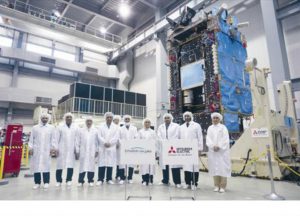
Executives from Qatar’s Es’hailSat and Japan’s Mitsubishi Electric Space Systems (MELCO) gathered in Kamakura, outside of Tokyo, Japan, to observe the vacuum chamber test of Es’hail-2.
MELCO, who were awarded the contract to build Es’hail-2 in 2014, hosted their Qatari clients on 4 June 2016.
Es’hail-2 is based on MELCO’s DS-2000 bus that features highly reliable design and production based upon deep experience derived from participation in more than 280 satellite projects worldwide; capable of providing an output of up to 15 kilo-Watts, satisfying the power requirements for powerful and multiple communications transponders; and flexible design that matches various applications including hybrid communications payloads.
The vacuum chamber test is designed to simulate the harsh conditions of outer space in order to test whether the satellite can withstand the rigours of space operations and function as planned in a variety of environmental conditions. Attending the test was the Es’hailSat Chairman, Dr Hessa Sultan Al Jaber, along with other members of the Es’hailSat board of directors.
Dr. Al Jaber said, “The Es’hail-2 will enhance the strength and importance Es’hailSat, which began to take a pivotal role in the region since the launch of the first satellite, Es’hail-1 in August 2014.”
Es’hail-2 will be launched on a SpaceX Falcon-9 from the Cape Canaveral launch facility in Florida, United States, in the first quarter of 2017.
The Es’hail-2 satellite will be positioned at the 26° East hotspot position for television broadcasting and significantly adds to Es’hailSat’s ability to provide high quality, premium Direct-to-Home (DTH) television content across the Middle East and North Africa. It will feature Ku-band and Ka-band transponders to provide TV distribution and government services to strategic stakeholders and commercial customers who value broadcasting and communications independence, interference resilience, quality of service and wide geographical coverage.
Es’hail 2 will also provide the first Amateur Radio geostationary communication capability linking Brazil and India. It will carry two Phase 4 Amateur Radio transponders.
 SpaceWatch.Global An independent perspective on space
SpaceWatch.Global An independent perspective on space

